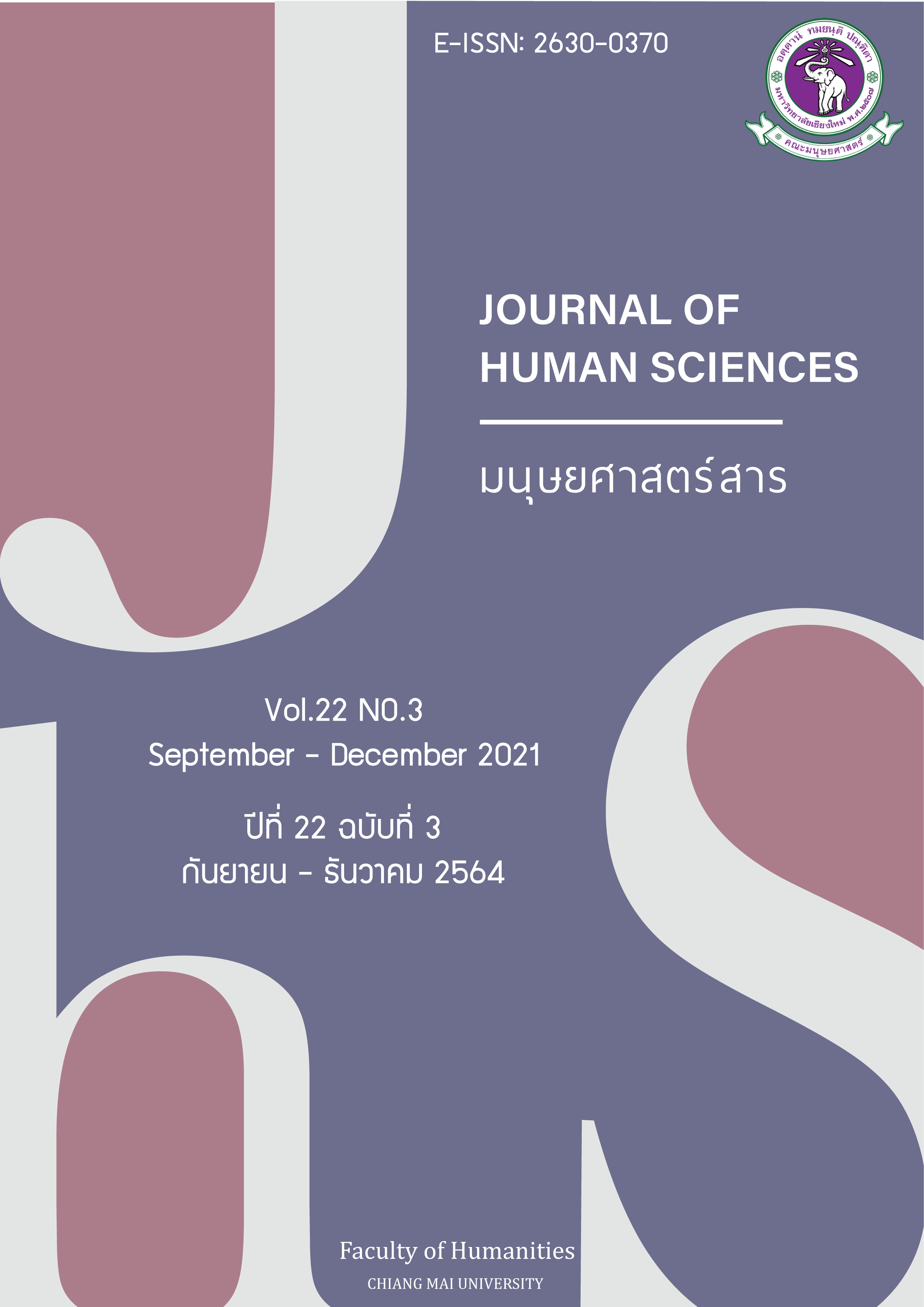ระดับของแรงจูงใจและกลวิธีในการเรียนวิชาภาษาอังกฤษของนักศึกษาระดับปริญญาตรี: กรณีศึกษา มหาวิทยาลัยในกำกับของรัฐ ในจังหวัดเชียงใหม่
Main Article Content
บทคัดย่อ
งานวิจัยนี้มีวัตถุประสงค์เพื่อหาระดับแรงจูงใจและกลวิธีในการเรียนภาษาอังกฤษเพื่อเตรียมพร้อม ก่อนออกฝึกสหกิจในสถานประกอบการของนักศึกษาระดับปริญญาตรีชั้นปีที่ 3 สาขาการจัดการ คณะบริหารธุรกิจ มหาวิทยาลัยแม่โจ้ จำนวน 134 คน และทัศนะของอาจารย์ผู้สอนภาษาอังกฤษในระดับปริญญาตรี จำนวน 5 คน ถึงวิธีการจัดการเรียนการสอนที่จะส่งเสริมและสร้างแรงจูงใจให้แก่ผู้เรียน
ผู้วิจัยได้ใช้แบบสอบถามระดับแรงจูงใจ ซึ่งดัดแปลงมาจากแบบสอบถาม กลยุทธ์เพื่อการสร้างแรงจูงใจในการเรียน (MSLQ) โดย Pintrich (1991) ในการกำหนดจำนวนประชากร และการใช้คำถามเชิงลึกเพื่อสัมภาษณ์อาจารย์ผู้สอนภาษาอังกฤษ โดยแบบสอบถามที่สร้างขึ้นแบ่งออกเป็นสองส่วนได้แก่ (1) แรงจูงใจ (2) กลวิธีในการเรียนภาษาอังกฤษ
จากข้อมูลแบบสอบถาม นักศึกษาส่วนใหญ่รู้ว่าภาษาอังกฤษมีประโยชน์ (x = 5.48) มีความสำคัญ (x = 5.16) แต่มีความกังวลในการสอบ (x = 5.01) ตามลำดับ ในส่วนของกลวิธีในการเรียนนั้น พบว่า นักศึกษาพยายามจดจำเนื้อหาเพื่อการสอบ (x = 4.98) พยายามเรียนรู้จากข้อผิดพลาดเมื่อสอบได้คะแนนน้อย (x = 3.79) และ พูดคำศัพท์ซ้ำ ๆ เพื่อจดจำเนื้อหา (x = 3.72) ตามลำดับ จากการสัมภาษณ์ผู้สอนภาษาอังกฤษ พบว่ากิจกรรมที่จะช่วยส่งเสริมการเรียนรู้ ได้แก่ การใช้เกมส์ สื่อ หัวข้อตามความสนใจของผู้เรียน การประยุกต์การเรียนรู้กับสถานการณ์ปัจจุบัน การเรียนรู้แบบร่วมมือและลงมือทำ และการเรียนรู้ตามภูมิหลังทางวัฒนธรรมของผู้เรียน วิธีการสอนที่สร้างแรงจูงในในการเรียนภาษาอังกฤษให้แก่นักศึกษามากที่สุด คือ สื่อออนไลน์และสื่อสภาพจริง กิจกรรมการเรียนรู้แบบร่วมมือ กระบวนการคิดเชิงออกแบบ การสอนภาษาอังกฤษเชิงวัฒนธรรมและชุมชนของผู้เรียน โดยให้ผู้เรียนเป็นศูนย์กลาง และปัจจัยที่เป็บอุปสรรคต่อแรงจูงใจในเรียนภาษาอังกฤษ คือ การขาดความรู้พื้นฐานภาษาอังกฤษ บรรยากาศและการจัดการห้องเรียน เทคนิคการสอน การไม่เห็นถึงความสำคัญในการนำภาษาอังกฤษไปใช้ในอนาคต การมีทัศนคติเชิงลบ และความสัมพันธ์เชิงอำนาจในห้องเรียน
ผู้วิจัยเสนอว่า สำหรับการอบรมภาษาอังกฤษเพื่อเตรียมการปฏิบัติสหกิจศึกษา ควรจัดกิจกรรมการเรียนการสอนที่ทำให้ผู้เรียนไม่เกิดความกังวล มีการประเมินผลตามสภาพจริงแทนการทำข้อสอบ และมีการผสมผสานภูมิหลังทางวัฒนธรรมและชุมชนของผู้เรียนในการเรียนการสอน
Article Details

อนุญาตภายใต้เงื่อนไข Creative Commons Attribution-NonCommercial-NoDerivatives 4.0 International License.
เอกสารอ้างอิง
Al Othman, F. H., & Shuqair, K. M. (2013). The Impact of Motivation on English Language Learning in the Gulf States. International Journal of Higher Education, 2(4), 123-130.
Chaleam and Topeongpong (2019). Learning Motivation of Students in German program of Khonkaen University. Journal of Language Religion and Culture, 71-94.
Clement, R. (2006). Motivation, self-confidence, and group cohesion in the foreign language classroom. Language Learning, 44, 417-488.
Dincer, A., & Yesilyurt, S. (2017). Motivation to Speak English: A Self-Determination Theory Perspective. PASAA: Journal of Language Teaching and Learning in Thailand, 53, 1-25.
Dornyei, Z. (2002). Motivational strategies in the language classroom. Cambridge: University Press.
Ferdian, N. R. (1). Language Learning Strategies Used by International Students in Learning the Thai Language. Walailak Journal of Learning Innovations, 2(2), 79-93. Retrieved from https://so03.tci-thaijo.org/index.php/jliwu/article/view/95076
Gardner, R.C. (1985). Social psychology and second language learning: The role of attitudes and motivation. London: Edward Arnold Publishers.
Harmer, J. (1991). The practice of English language teaching. London: Longman.
Ketamon, T., Sudinpreda, H., Watcharajinda, A., Phayap, N. N., & Chanchayanon, A. (2020). Students’ Attitudes towards English Learning through English Camp at Princess Ubolratana Rajakanya’s College Phattalung. Journal of Education Naresuan University, 22(2), 19-30.
Pintrich, P. R. (1991). A manual for the use of the Motivated Strategies for Learning Questionnaire (MSLQ).
Reeve, J. (2016). Autonomy-supportive teaching: What it is, how to do it. In W. C. Liu, J. C. K. Wang, & R. M. Ryan (Eds.), Building autonomous learners perspectives from research and practice using self-determination theory (pp. 129–152). New York: Springer.
Soranastaporn (2017). Direct Language Learning Strategies of Thai Learners in Thailand 4.0. Academic Journal Thonburi University, 9-23.
Sugita McEown, M., & Takeuchi, O. (2014). Motivational strategies in EFL classrooms: how do teachers impact students' motivation?. Innovation in Language Learning and Teaching, 8(1), 20-38.
Tung, K. S., Ning, W. W., & Kris, L. (2014). Effect and Resilience on Self-Perceived Stress and Experiences on Stress Symptoms A Surveillance Report. Universal Journal of public health, 2(2), 65-72.
Vaezi, Z. (2008). Language learning motivation among Iranian undergraduate students. World Applied Sciences Journal, 5(1), 54-61.
Wang, L., & Vibulphol, J. (2015). Motivational strategies for English classrooms in Thailand: Perspectives of English teachers. An Online Journal of Education, 10(1), 429-443.
Wharton, G. (2000). Language learning strategy use of bilingual foreign language learner in Singapore. Language Learning, 50(2), 203–243.
Wong, S. L. (2005). Language Learning Strategies and language self-efficacy: Investigating the relationship in Malaysia. RELC Journal, 36(3), 245-269.
Yamane, T. (1967). Problems to accompany" Statistics, an introductory analysis". Harper & Row.


